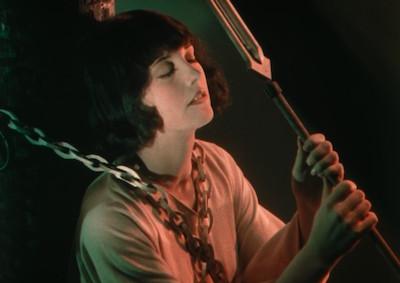Please review our required COVID-19 precautions and updated admission policy.
Los Angeles restoration premiere!
Preservation funding provided by the Hobson/Lucas Family Foundation
Mystery of the Wax Museum
U.S., 1933
The last and best of Hollywood’s two-color Technicolor features, Mystery of the Wax Museum was Warner Bros.’ follow-up to its horror-thriller Doctor X (1932), reprising much of the same cast and crew, including director Michael Curtiz and stars Lionel Atwill and Fay Wray. Wax Museum surpassed its precursor at the box office but took on legendary status after it fell out of circulation and was thought to be lost for decades. While a nitrate print of the film was discovered in 1969, it wasn’t until 2019 when the UCLA Film & Television Archive and The Film Foundation were able to utilize modern restoration techniques—and another nitrate print source —to give the film a digital restoration upgrade.
Atwill plays a sculptor of realistic historical figures who loses them all in an act of arson that destroys his London museum. Badly injured in the blaze, he relocates to New York City where people and corpses begin to disappear in the run up to the opening of his new exhibition. Glenda Farrell’s plucky reporter is on the case—with an assist in comic verve from Frank McHugh, as her editor—with Fay Wray drawn into the gruesome doings owing to her uncanny resemblance to Marie Antoinette. For a film about an artist driven to madness by realism, Curtiz and his principal creative team, cinematographer Ray Rennahan and production designer Anton Grot, lean heavily into the decidedly unnatural, eerie hues of the two-color process. The result is one of the most visually striking, eerily atmospheric horror films of the classic Hollywood era—finally restored to its original, lurid glory.
35mm, Technicolor, 77 min. Director: Michael Curtiz. Screenwriter: Don Mullaly, Carl Erickson. With: Lionel Atwill, Fay Wray, Glenda Farrell.
Restored by the UCLA Film & Television Archive and The Film Foundation in association with Warner Bros. Entertainment from two 35mm two-color Technicolor nitrate print sources. Laboratory services by Roundabout Entertainment, Inc., Fotokem, Audio Mechanics, DJ Audio, Inc., Warner Bros. Post Production Creative Services—Picture. Special thanks to Steven Anastasi, The Packard Humanities Institute.
Los Angeles restoration premiere!
Preservation funding provided by the Hobson/Lucas Family Foundation
Doctor X
U.S., 1932
The first horror feature shot entirely in color, Doctor X is also one of the earliest American serial killer movies—and a serial killer with cannibalistic tendencies, at that! Even with all this going for it, the color version of Doctor X almost became a lost film after the industry shifted from two-color to three-color Technicolor and the Production Code Administration imposed new strictures on content in 1934. Warner Bros. took pains to shoot a black-and-white version simultaneous with the color production (much to the chagrin of Technicolor) but the full spine-chilling impact of the film’s lighting and production design—intended to be seen in color—remained blunted for decades until this new digital restoration by the UCLA Film & Television Archive and The Film Foundation.
After a series of gruesome murders occur under the full moon, the victims found partially eaten, suspicion falls on the coterie of oddball scientists working at a famed but secretive medical academy. Its director, Dr. Xavier (Lionel Atwill), promises the cops he has an experimental technique that can clear their names, but even with the help of his daughter (Fay Wray) and a reporter (Lee Tracy), who stumbles on the scene, things go horribly awry. The most gruesome of the early sound horror movies, Doctor X is awash in ghoulish greens and reds—courtesy of cinematographer Ray Rennahan and production designer Anton Grot under Michael Curtiz’s direction—that punch up the unease until the film’s climactic and bizarre finale.
35mm, Technicolor, 76 min. Director: Michael Curtiz. Screenwriter: Robert Tasker, Earl Baldwin. Based on the play The Terror by Howard W. Comstock and Allen C. Miller. With: Lionel Atwill, Fay Wray, Lee Tracy.
Restored by the UCLA Film & Television Archive and The Film Foundation in association with Warner Bros. Entertainment from a 35mm two-color Technicolor nitrate print and a nitrate fragment. Laboratory services by Roundabout Entertainment, Inc., Fotokem, Audio Mechanics, DJ Audio, Inc., Warner Bros. Post Production Creative Services—Picture. Special thanks to Steven Anastasi, The Library of Congress.
Special thanks to The Film Foundation.






 Mobile Navigation
Mobile Navigation

